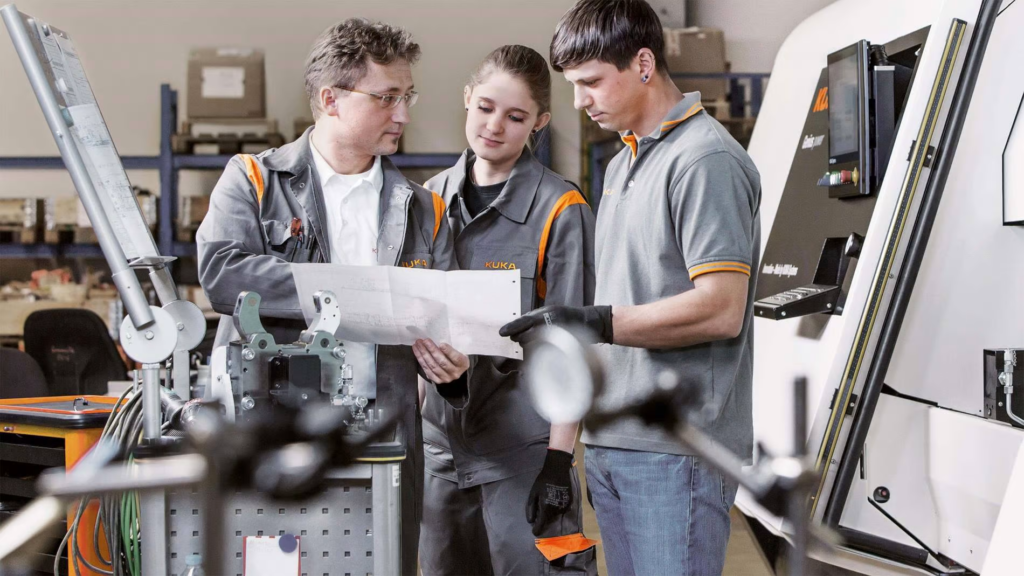Free Lathe Operator Course (6Months)
Lathe Operator CLICK HERE
Brief Job Description
A Lathe Operator is responsible for setting up, operating and monitoring lathe or turning machines, shaping or threading wire, rod or bar stock. A lathe operator studies blueprints and tooling instructions to determine the correct procedure for machining the component in such a manner that facilitates maximum efficiency in tool usage and time. The operator also performs machine maintenance and checks tools for signs of wear.
Personal Attributes
The job requires an individual to work long hours. The individual should have good understanding of the Lathe machine including technical aspects, associated tools and equipment. The individual should have proper knowledge of the service related activities, schedules and preventive maintenance of the Lathe machine. The individual should be hard working and should have manual dexterity.

Plan and organise work to meet expected outcomes:
Elements and Performance Criteria
Work requirements including various activities within the given time and set quality standards
To be competent, the user/individual on the job must be able to:
PC1. keep immediate work area clean and tidy
PC2. treat confidential information as per the organisations guidelines
PC3. work in line with organisations policies and procedures
PC4. work within the limits of job role
PC5. obtain guidance from appropriate people, where necessary
PC6. ensure work meets the agreed requirements
Appropriate use of resources
To be competent, the user/individual on the job must be able to:
PC7. establish and agree on work requirements with appropriate people
PC8. manage time, materials and cost effectively
PC9. use resources in a responsible manner
Knowledge and Understanding (KU)

The individual on the job needs to know and understand:
KU1. the organisations policies, procedures and priorities for area of work, role and responsibilities in carrying out that work
KU2. the limits of responsibilities and when to involve others
KU3. specific work requirements and who these must be agreed with
KU4. the importance of having a tidy work area and how to do this
KU5. how to prioritize workload according to urgency and importance and the benefits of this
KU6. the organisations policies and procedures for dealing with confidential information and the importance of complying with these
KU7. the purpose of keeping others updated with the progress of work
KU8. who to obtain guidance from and the typical circumstances when this may be required
KU9. the purpose and value of being flexible and adapting work plans
KU10. how to complete tasks accurately by following standard procedures
KU11. technical resources needed for work and how to obtain and use these
Generic Skills (GS)

User/individual on the job needs to know how to:
GS1. write in at least one language
GS2. read instructions, guidelines/procedures
GS3. ask for clarification and advice from appropriate persons
GS4. communicate orally with colleagues
GS5. make a decision on a suitable course of action appropriate for accurately completing the task within resources
GS6. agree objectives and work requirements
GS7. plan and organise work to achieve targets and deadlines
GS8. deliver consistent and reliable service to customers
GS9. check own work and ensure it meets customer requirements
GS10. anomalies to the concerned persons
GS11. analyse problems and identify work-arounds taking help from
GS12. apply own judgement to identify solutions in different situations

Work effectively in a team:
Elements and Performance Criteria
Effective communication
To be competent, the user/individual on the job must be able to:
PC1. maintain clear communication with colleagues
PC2. work with colleagues
PC3. pass on information to colleagues in line with organisational requirements
PC4.. work in ways that show respect for colleagues
PC5. carry out commitments made to colleagues
PC6. let colleagues know in good time if cannot carry out commitments, explaining the reasons
PC7. identify problems in working with colleagues and take the initiative to solve these problems
PC8. follow the organisations policies and procedures for working with colleagues
PC9. ability to share resources with other members as per priority of tasks
Knowledge and Understanding (KU)
The individual on the job needs to know and understand:
KU1. the organisations policies and procedures for working withcolleagues, role and responsibilities in relation to this
KU2. the importance of effective communication and establishing goodworking relationships with colleagues
KU3. different methods of communication and the circumstances inwhich it is appropriate to use these
KU4. benefits of developing productive working relationships withcolleagues
KU5. the importance of creating an environment of trust and mutualrespect
KU6. whether not meeting commitments, will have implications onindividuals and the organisation
KU7. different types of information that colleagues might need and theimportance of providing this information when it is required
KU8. the importance of problems, from colleagues perspective andhow to provide support, where necessary, to resolve these
Generic Skills (GS)
User/individual on the job needs to know how to:
GS1. complete well written work with attention to detail
GS2. read instructions, guidelines/procedures
GS3. listen effectively and orally communicate information
GS4. make decisions on a suitable course of action or response
GS5. plan and organise work to achieve targets and deadlines
GS6. check that the work meets customer requirements
GS7. deliver consistent and reliable service to customers
GS8. apply problem solving approaches in different situations
GS9. apply balanced judgements to different situations
GS10. apply good attention to detail
GS11. check that the work is complete and free from errors
GS12. get work checked by peers
GS13. work effectively in a team environment

Maintain a healthy,safe and secure working environment:
Elements and Performance Criteria
Resources needed to maintain a safe, secure working environment
To be competent, the user/individual on the job must be able to:
PC1. comply with organisations current health,safety and security policies and procedures
PC2. report any identified breaches in health,safety, and security policies and procedures to the designated person
PC3.. Coordinate with other resources at the workplace to achieve the healthy, safe and secure environment for all incorporating all government norms esp. for emergency situations like fires,earthquakes etc.
PC4. identify and correct any hazards like illness, accidents, fires or any other natural calamity safely and within the limits of individuals authority
PC5. report any hazards outside the individuals authority to the relevant person in line with organisational procedures and warn other people who may be affected
PC6. follow organisations emergency procedures for accidents, fires or any other natural calamity
PC7. identify and recommend opportunities for improving health,safety, and security to the designated person
PC8. complete all health and safety records are updates and procedures well defined
Knowledge and Understanding (KU)
The individual on the job needs to know and understand:
KU1. legislative requirements and organisations procedures for health, safety and security and individuals role and responsibilities in relation to this
KU2. what is meant by a hazard, including the different types of health and safety hazards that can be found in the workplace
KU3. how and when to report hazards
KU4. the limits of responsibility for dealing with hazards
KU5. the organisations emergency procedures for different emergency situations and the importance of following these
KU6. the importance of maintaining high standards of health, safety and security
KU7. implications that any non-compliance with health, safety and security may have on individuals and the organisation
KU8. different types of breaches in health, safety and security and how and when to report these
KU9. evacuation procedures for workers and visitors
KU10. how to summon medical assistance and the emergency services,where necessary
KU11. how to use the health, safety and accident reporting procedures and the importance of these
Generic Skills (GS)
User/individual on the job needs to know how to:
GS1. complete accurate, well written work with attention to detail
GS2. read instructions, guidelines/procedures/rules
GS3. listen and orally communicate information
GS4. make decisions on a suitable course of action or response
GS5. plan and organise work to achieve targets and deadlines
GS6. build and maintain positive and effective relationships withcolleagues and customers
GS7. apply problem solving approaches in different situations
GS8. analyse data and activities
GS9. apply balanced judgements to different situations
GS10. apply good attention to detail
GS11. check that the work is complete and free from errors
GS12. get work checked by peers
GS13. work effectively in a team environment

Perform and finish all assigned jobs on Lathe machine:
Elements and Performance Criteria
Machine various aggregates through a Lathe Machine
To be competent, the user/individual on the job must be able to:
PC1. set up and operate numerically controlled horizontal lathe to perform operations, such as turning, boring, facing, and threading parts, such as castings, forgings and bar stock
PC2. understand machine operation and adjust controls to ensure conformance with specified tolerances
PC3. set tools before positioning them in lathe, using precision gauges and instruments
PC4. mount work piece between centres, in chuck, or to faceplate, manually or using hoist
PC5. select and install pre-set tooling in tool posts, turrets or indexing heads, and automatic-tool- change magazine, in sequence specified on process sheet
PC6. . depresses buttons, toggles, or sets tape and starts machining operation
PC7. set cutting specifications and position cutting tool and work piece in relation to each other, and start machine
PC8. select cutting speed, feed rate, and depth of cut
PC9.. move cutter or material manually or by turning hand wheel to mill work piece to specifications
PC10. numerical displays on control panel and compares with data on process sheet to verify dimensional adjustments, feed rates, and speeds of machining cuts
PC11. verify alignment of work piece on machine, using measuring instruments, such as rules, gauges, or callipers
PC12. install, align & secure tools, attachments, fixtures & work pieces on machines, using hand tools & precision measuring instruments
PC13. dials and switches to override tape control and correct machine performance, applying practical knowledge of lathe operation
PC14. inspects first-run piece and spot-checks succeeding pieces for conformance to specifications, using micrometers and precision dial gauges.
PC15. job packet and organizes materials for next run during automatic tapecontrolled cycles to shorten changeover time
PC16. ensure that the piece meets specifications after completing finishing works
PC17. all machine malfunctions to supervisor
PC18.. change worn tools and perform routine maintenance
Knowledge and Understanding (KU)
The individual on the job needs to know and understand:
KU1. standard operating procedures for performing operations related to lathe machine
KU2. process flow of lathe operations performed
KU3. organisational and professional code of ethics and standards of practice
KU4. safety and health policies and regulations for the workplace
KU5. how to operate and control machining operations related to lathe machine such as : turning operations drilling milling (peripheral and facing milling) boring shaping and planning broaching sawing cutting operations knurling taper turning
KU6. to adjust a rotating speed, a cutting depth and a sending speed of lathe machine
KU7. how to use and handle tools related with operating lathe machine including : chuck face plate collate engine lathe chucking machine bar machine drill press vice, jig and fixture milling cutters pallet shuttles swarfs spindle morse taper
KU8. to handle loading and unloading of lathe parts
KU9. to protect lathe parts from damage during loading and set up
KU10. to operates a forklift or lifting devices for movement of parts
KU11. to position, secure, and align cutting tools in tool holders on machines, using hand tools, and verify their positions with measuring instruments
KU12. select and set cutting speed, feed rate, and depth of cut
KU13. compute unspecified dimensions and machine settings, using knowledge of metal properties and shop mathematics
KU14. how to replace worn tools, and sharpen dull cutting tools and dies using bench grinders or cutter-grinding machines
KU15. how to retest and modify the lathe machine program to enhance efficiency
Generic Skills (GS)
User/individual on the job needs to know how to:
GS1. complete and maintain workplace records on inspection, diagnosis and repair activities
GS2. maintain all office records required on the job (e.g. stock records, job cards,repair quotations, personnel records, time sheets, meeting notes etc.)
GS3. record all diagnostic inspections and tests carried out on a vehicle
GS4. write in at least one language
GS5. read process sheets, blueprints, and sketches of part to determine machining to be done, dimensional specifications, set up, and operating requirements
GS6. read and interpret geometric dimensions and tolerances in the job to be done involving the lathe machine
GS7. interact with superiors and other support staff
GS8. communicate with supervisor, engineers, production control, quality and other shop personnel for assignments and to resolve lathe machining or quality issues
GS9. determine the nature and objective of the analysis and evaluation required and decide on the diagnostic techniques to be applied
GS10. plan work according to the pendencys as reported for repair / machining of the various components on a daily basis and provide estimates of time required for each piece of work (e.g. by evaluating work assigned on a job card and providing time estimates for each service/ repair activity)
GS11. prioritise actions to achieve required outcomes to quality machining of the components within the given tolerance levels
GS12. ensure that customers requirements are assessed and satisfactory service is provided
GS13. recognise a workplace problem or a potential problem and take action
GS14. determine problems needing priority action
GS15. refer problems outside area of responsibility to concerned person (e.g. unavailability of required spare parts or materials in the workshop)
GS16. gather information and provide assistance as required to solve problems
GS17. analyse the complexity of work to determine if it can be successfully carried out
GS18. analyse, evaluate and apply the information gathered from observation,experience, reasoning, or communication to act efficiently
Assessment Guidelines:
- Criteria for assessment for each Qualification Pack will be created by the Sector Skill Council. Each Element/ Performance Criteria (PC) will be assigned marks proportional to its importance in NOS. SSC will also lay down proportion of marks for Theory and Skills Practical for each Element/ PC.
- The assessment for the theory part will be based on knowledge bank of questions created by the SSC.
- Assessment will be conducted for all compulsory NOS, and where applicable, on the selected elective/option NOS/set of NOS.
- Individual assessment agencies will create unique question papers for theory part for each candidate at each examination/training center (as per assessment criteria below).
- Individual assessment agencies will create unique evaluations for skill practical for every student at each examination/ training center based on these criteria.
- To pass the Qualification Pack assessment, every trainee should score the Recommended Pass % aggregate for the QP.
- In case of unsuccessful completion, the trainee may seek reassessment on the Qualification Pack.







